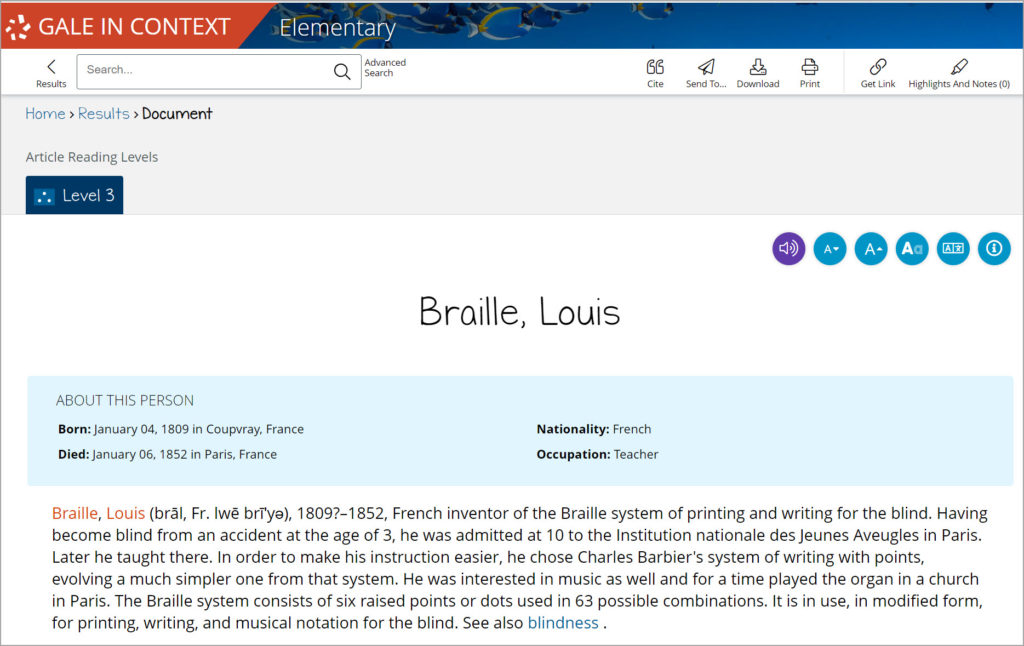| By Gale Staff |
By bringing awareness to disabilities and the various ways of learning, educators can elevate diversity, equity, and inclusion initiatives in the classroom. This January, set students on a path of discovery and understanding by integrating the topic of braille into your lesson plans. Start by taking a look at information and ideas from Gale In Context: Elementary that you can use in your elementary classroom.
Literacy is key to academic achievement, and braille is an important accessibility tool for people with vision impairment. Encourage your students to explore different ways of learning during National Braille Literacy Month.
Share the History of Braille
We celebrate braille in January to commemorate the birthday of Louis Braille, the inventor of the braille system. In the early nineteenth century, Louis created braille as a simpler reading tool that uses a tactile coding system for visually impaired people. Braille is a reading and writing system that’s based on patterns of raised dots; people all around the world use braille because the system easily adapts to different languages.

Louis Braille’s parents believed their child deserved an education that wasn’t limited by his visual disability. As a student, he had a resolute commitment to learning and relied on his hearing to understand his instructors. At the age of 10, Louis received a scholarship to the National Institute for Blind Youth in Paris. It was there that Louis discovered “night writing,” a military tool used by soldiers to communicate at night without speaking or turning on a lantern.
Night writing helped soldiers avoid giving away their location to an enemy. The military code relied on groupings of embossed dots, which could be reorganized to indicate different numbers and letters. Inspired by this process, Louis adapted his own tactile reading system based on 63 combinations of raised dots when he was only fifteen years old.
While braille isn’t technically its own language, it’s been translated into several others, including Chinese, Arabic, and Spanish. Beyond reading, braille is also used in mathematics and music.
Activity Idea: Using the braille alphabet image in Gale In Context: Elementary, have students copy the dot patterns to write their own names in braille. You can use graph paper to gently press out the dots and flip the page over to feel how your name reads in braille.
Create Engaging Lessons for the Classroom
Help your students learn more about the history of braille and other historical figures who were visually impaired using age-appropriate content in Gale In Context: Elementary. Our curated collection of resources is designed to be accessible to young learners and adaptable for various grade levels.

Start your class with the summary articles in Gale In Context: Elementary. These resources provide elementary readers with important information that is formatted using simple sentence structures and age-appropriate vocabulary. Articles are available at different Lexile reading levels as well, enabling advanced readers to discover the same content but crafted for students who are ready for more challenging exercises.
Gale resources include additional features to make learning more accessible for everyone. Teach your students about the supplemental tools within these articles that assist visually impaired students, like the text-to-speech function and customization of text size and color.
Activity Idea: Have students research other historical figures who had visual impairments, record their accomplishments, and share their findings with the class.
Find Braille Outside the Classroom
Once your students understand the basics, they can explore Gale’s magazine and news pieces to learn more about how braille is used all around them. Gale In Context: Elementary provides a structured, safe environment for young learners to practice their online research skills. They can find kid-friendly articles that showcase the real voices and experiences of visually impaired people, such as the mother and daughter who ran hundreds of miles for the Braille Across America Challenge.
Braille may be centuries old, but your students can see how relevant and adaptable braille remains. A braille smartphone and Starbucks gift cards that feature braille are just a couple of examples. Ask your students where else they’ve seen braille used. Maybe in an elevator or on an entrance sign? Have them consider why it’s important to include braille in public spaces. Did they know that the bumps at the edge of some sidewalks and street crossings are a form of braille? This tactile paving helps a person who is blind avoid dangerous curbs and busy traffic.
Activity Idea: Mancala is a great counting game to introduce to your young learners; plus, it’s a popular game for children who have visual impairments. Once they’ve played, ask students what characteristics Mancala has that make it such an all-inclusive game. For example, all of the pieces are the same size, so you don’t need to see them to count them.
Braille Literacy Month is an excellent time to recognize the contributions of Louis Braille and other famous figures who were visually impaired. You can also use the opportunity to teach students about the different ways people learn with visual impairments. With the kid-friendly, unbiased content in Gale In Context: Elementary, your students and patrons can read and reflect on the challenges that others face and grow to be inclusive, considerate learners themselves.
Not a Gale In Context subscriber? Learn more about Gale In Context: Elementary or contact your rep.

